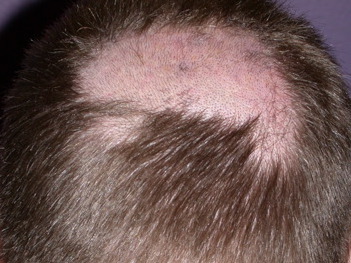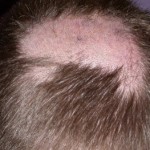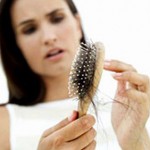Alopecia areata
Alternative Names: Alopecia totalis; Alopecia universalis
Alopecia areata is a condition that causes round patches of hair loss, and can lead to total hair loss.
Causes of Alopecia areata
The cause of alopecia areata is unknown. About a fifth of people with this condition have a family history of alopecia.
Alopecia areata is thought to be an autoimmune condition. This occurs when the immune system mistakenly attacks and destroys healthy body tissue.
Alopecia areata is seen in men, women, and children. A major life event such as an illness, pregnancy, or trauma occurs before the hair loss in some, but not most patients
Forms of alopecia include:
- Alopecia areata — patches of hair loss, usually on the scalp, but they also can be in the beard or other areas
- Alopecia totalis — complete loss of scalp hair
- Alopecia universalis — total loss of all body hair
Alopecia areata Symptoms
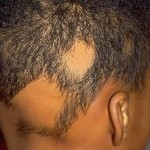 Most of the time there are no other symptoms besides hair loss, but some people may feel a burning sensation or itching.
Most of the time there are no other symptoms besides hair loss, but some people may feel a burning sensation or itching.
Alopecia areata usually begins as one to two patches of hair loss, most often on the scalp. It may also be seen in the beard, eyebrows, and arms or legs.
Roundish patches of hair loss are smooth, and may be peach-colored. Hairs that look like exclamation points are sometimes seen at the edges of a bald patch.
- Loss of all scalp hair (alopecia totalis), often within 6 months after symptoms first start.
- Loss of all scalp and body hair (alopecia universalis).
Tests and Exams
On occasion, a scalp biopsy may be performed. Several blood tests may be done, because alopecia areata may occur with autoimmune conditions.
Treatment of Alopecia areata
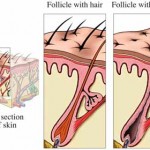 If hair loss is not widespread, the hair will likely regrow in a few months, whether or not treatment is used.
If hair loss is not widespread, the hair will likely regrow in a few months, whether or not treatment is used.
Even for more severe hair loss, it is not clear whether treatments will change the course of the condition.
Typical therapy may include:
- Steroid injection under the skin surface
- Topical corticosteroids
- Topical immunotherapy
- Topical minoxidil
- Ultraviolet light therapy
- Use of wigs
Irritating drugs may be applied to hairless areas to cause the hair to regrow.
Prognosis (Outlook)
Full recovery of hair is common.
However, some people may have a poorer outcome, including those with:
- Alopecia areata at a young age
- Eczema (atopic dermatitis)
- Long-term alopecia
- More widespread or complete loss of scalp or body hair
Potential Complications
Permanent hair loss is a possible complication of alopecia areata.
When to Contact a Health Professional
Call for an appointment with your health care provider if you are concerned about hair loss.
Female pattern baldness
Alternative Names: Alopecia in women; Baldness – female; Hair loss in women; Androgenetic alopecia in women
Female pattern baldness involves a typical pattern of hair loss in women, due to hormones, aging, and genes.
Causes of Female pattern baldness
A hair grows from its follicle at an average rate of about 1/2 inch per month. Each hair grows for 2 to 6 years, then rests, and then falls out. A new hair soon begins growing in its place. At any time, about 85% of the hair is growing and 15% is resting.
Baldness occurs when hair falls out and normal new hair does not grow in its place. The reason why new hair does not grow in female pattern baldness is not well understood, but it may be related to:
- Aging
- Changes in the levels of androgens (male hormones). For example, after reaching menopause, many women find that the hair on their head is thinner, while the hair on their face is coarser.
- Family history of male or female pattern baldness
Hair loss can occur in women for reasons other than female pattern baldness, including the following:
- Breaking of hair (from treatments and twisting or pulling of hair, or hair shaft abnormalities that are present from birth)
- Certain skin diseases that lead to scarring of the hair follicles
- Hormonal abnormalities, such as too much testosterone, or too much or too little thyroid hormone
- Iron deficiency
- Medications such as chemotherapy and beta blockers
- Patchy hair loss (alopecia areata)
- Syphilis
- Temporary shedding of hair (telogen effluvium) after a major illness, surgery, or pregnancy
- Vitamin deficiency (such as biotin)
Female pattern baldness Symptoms
Hair thinning is different from that of male pattern baldness. In female pattern baldness:
- Hair thins mainly on the top and crown of the scalp. It usually starts with a widening through the center hair part.
- The front hairline remains
- The hair loss rarely progresses to total or near total baldness, as it may in men
Itching or skin sores on the scalp are generally NOT seen.
